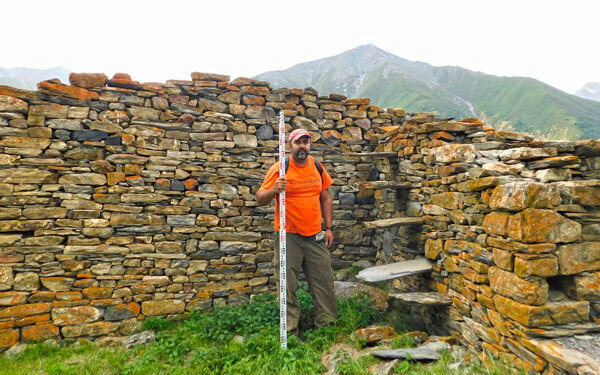 Professor David Berikashvili at Samshvilde in the Southern Caucasus
Professor David Berikashvili at Samshvilde in the Southern CaucasusThe Medieval Institute and the Department of Anthropology are pleased to present a lecture by David Berikashvili, professor in the Department of Archeology, Anthropology and Art at The University of Georgia, Tbilisi, Republic of Georgia.
The lecture will be followed by a reception.
About the Talk
Located in the southern Caucasus, in the Middle Ages the city-site of Samshvilde was an important stronghold and lively commercial and industrial city connected with the Silk Road. Along with Tbilisi and Mtskheta, Samshvilde is listed as one of the three main cities in this region in the 7th century Armenian geography by Shirakatsi. At the end of the 10th century, Samshvilde became the capital of the Armenian Kings of Tashir-Dzoraget and was part of the Kingdom of Georgia from 1064 onward when it became the main fortress and the political-economic center of the region. Located to the west of Tblisi on a rocky river promontory between the Khrami and Chivchava rivers, the ruins of the city stretch for at least a mile and a half in length and 1300 feet in width. The city occupies a large area, including a fortified citadel, water cisterns, baths, several cemeteries, palaces, and the ruins of several churches. The citadel consists of massive defensive walls, towers and gates, and three significant churches. This includes Sioni Church with foundational inscriptions dating to the 8th century. Unlike so many other city-sites of this period, Samshvilde was largely abandoned by the end of the 18th century, and today the site is overgrown with trees, untouched by economic development, and surprisingly well-preserved.
Archaeological excavations under the direction of Professor Berikashvili since 2012 have demonstrated that between the 10th and the mid-11th century, Samshvilde was the capital of the Armenian kings and was one of the most important strongholds and lively commercial cities in the Caucasus. Drawing upon archaeological excavations, historic literature, comparative art history, and geophysical surveys of the site, this presentation illustrates how the interdisciplinary study of this medieval city-site helps us better understand regional trade along the northern branch of the Silk Road. Looking at archaeological data, this study illustrates how various ethnic groups and cultures interacted at Samshvilde, and how this region can be viewed as a contested landscape during the ages of early empires and trade networks.
About the Speaker
After graduating from Tbilisi State University in 2004, Professor Berikashvili started his archaeological work at the Georgian National Museum in Tbilisi as a senior scientist. He was a part of several international projects run by the GNM, the DAI (Deutche Archaeologische Institute) and Harvard's Peabody Museum in the western and eastern parts of Georgia. After completing his 2006 Ph.D. thesis, “The Early and Middle Bronze Age Settlements and Cemeteries from West Georgia (South Caucasus)", he was invited by The University of Georgia, Tbilisi, to take the position of associated professor and the director of Samshvilde projects. Since 2012 he has led the team of archaeologists excavating the Samshvilde site and the team of Georgian students working in the Fars region, Iran, on the Persepolis world heritage site. His main interests are focused on studies of the medieval Caucasus and the Near East and the cultural relationship between Caucasian and Iranian worlds in particular.
Originally published at medieval.nd.edu.